Rider on wheels
Caterpillar tractor chassis, and then tanks It turned out to be not only much more difficult technically, but also much more expensive. The tactics of the combat use of tank units in the 1920s and 1930s have not yet been worked out. The role and place of self-propelled artillery was not clearly visible, and self-propelled artillery as such did not exist. Therefore, the developers did not see the significant advantages of tracked chassis over wheeled ones. Moreover, the automotive industry at that time developed rapidly. A new impetus to the creation of self-propelled guns on wheeled chassis gave the appearance of off-road vehicles. The most successful design of this kind should be recognized as the French self-propelled guns on the chassis of the Laffly all-terrain truck, armed with a 47mm anti-tank gun.
The beginning of the Second World War put an end to the competition between tracked and wheeled self-propelled guns. The nature of the conduct of hostilities clearly demanded the presence on the battlefield of self-propelled guns created on the tank chassis. Only in this way was their close interaction with tanks ensured. The wheel-mounted ACS did not have sufficient cross-country ability or armor protection for the required level. Self-propelled guns built on the chassis of half-tracked armored personnel carriers can only be considered as an auxiliary weapon system with limited capabilities. They acted mainly in the battle formations of motorized infantry units equipped with semi-tracked armored personnel carriers. By the end of the war, the concept of a self-propelled artillery installation on a tank chassis had finally triumphed. But, as it soon turned out, not for long.
In the first post-war decades, anti-tank destroyers disappeared from the arsenals of the leading military powers of the world. The fight against enemy tanks was fully laid on tanks and anti-tank missile systems. And the latter could be mounted on anything - from helicopters to jeeps. The need to escort tanks in a battle with self-propelled guns has disappeared, and as a result, the requirements for the level of armor protection of the latter have decreased. By the beginning of the 1970s in different countries, lightly armored self-propelled guns, created either on the chassis of tracked armored personnel carriers or on special chassis, began to enter service. And it was only about self-propelled howitzers of caliber from 105 to 203 mm. With the reduction in the combat mass of these SAUs, the temptation to use the wheeled chassis again arose, especially since by that time there were already many samples of automotive vehicles that were not inferior in traction to tracked vehicles. Czechoslovakia became a pioneer in creating wheeled self-propelled guns of the new generation.
It should be noted that the armies of the countries participating in the Warsaw Pact in the main were equipped with Soviet-made armament and military equipment. Together, those countries that had the appropriate defense industry were not forbidden to develop their own designs both for their own needs and for other allied states. The only requirement was only the unification of ammunition.
152 mm ShKH vz.77 (152 mm samohydna kanonova houfnice vz. 77 - 1 52MM self-propelled gun-howitzer model 1977 of the year)
In the middle of 1970 in the design office of a machine-building enterprise in the Slovak city of Dubnica nad Vahom, a new software was built. sample 152 of the year). However, this self-propelled gun, launched into a series in the 77 year, gained great fame under its own name - “Dana”.
The Tatra 815 all-wheel-drive chassis, seriously upgraded for this purpose, was used as a base for placing weapons in this SAU. The chassis has a wheel formula 8x8, with two front steering wheels. Suspension - independent spring. The wheels are equipped with a tire pressure control system. In front of the chassis is a low-profile armored cab. It houses the driver and commander. At the rear of the chassis is a 12 cylinder V-shaped multi-fuel Tatra 293034 diesel engine with 345 horsepower.
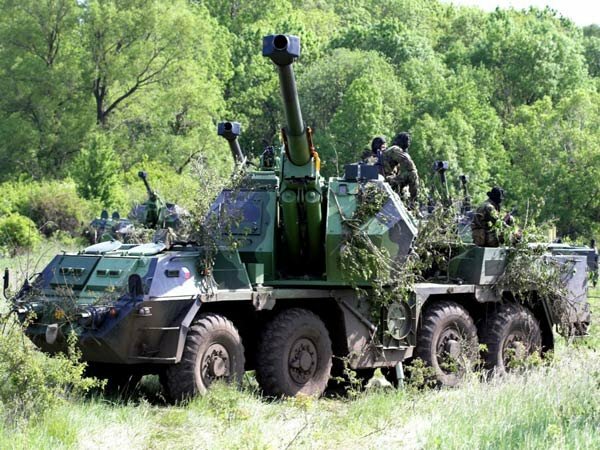
in 1979 year, acquired under its own name - "Dana"
Armament - 152mm howitzer gun - installed in a rotating turret consisting of two armored half-towers, sealed and isolated from each other. On the left are the gunner and loader jobs located in tandem, followed by the mechanized charging of charges. In the right - the workplace of the second loader, and in front of him - the mechanized laying of shells. The 12,7mm anti-aircraft gun DSHKM is installed on the turret of the second charging loader. The gun-howitzer gun carriage mounted openly between the semi-towers. Above the barrel of the gun is placed the mechanism of filing.
This installation of howitzer guns eliminates the effect of powder gases on the calculation when conducting intensive firing. Namely, such shooting is provided in automatic mode, when projectiles and charges are fed to the discharging line with the help of special mechanisms. Cartridges are removed by a special conveyor. In the automatic mode, “Dana” is capable of producing 30 shots in 7 minutes, and within an hour - 90 shots. With manual loading, the rate of fire is 2 rds / min. Ammunition - 60 shots. For firing, high-explosive fragmentation grenades from the Soviet gun-howitzer D20, including Czechoslovakia, are used. The maximum angle of elevation of the gun barrel is + 70 °, the declination is 4 °. Despite the fact that the installation in a combat position is hung out with the help of three hydraulic supports, it is possible to fire only in the 225 ° sector. The maximum firing range of an 43,5 kg fragmentation grenade mass is 18,7 km. The installation can be deployed in the firing position within 2 minutes, and leave it - a minute after the end of the shooting.
The engine allows the vehicle with a combat weight of 29,25 t to reach speed on the highway 80 km / h. Power reserve - 800 km.
At the beginning of 1980, the ACS "Dana" entered service in Czechoslovakia, Poland and the GDR. The Czechoslovak military leadership offered “Dana” to the Soviet Union, but this did not arouse much enthusiasm. In terms of fire capabilities, the “Dana” was identical (with the exception of the rate of fire) of the Soviet self-propelled howitzer 2SZ “Akatsiya”, which was already in service with the Soviet Army. True, thanks to the use of a wheeled chassis, the “Dana” possessed a higher mobility on the roads, but on the roads it was losing on the terrain of the tracked “Acacia”. This circumstance may not have been significant in the context of an extensive European road network, but for the territory of the USSR it was a clear disadvantage. A very serious lack of “Dana” was considered the lack of the possibility of loading from the ground.
In general, it was obvious that adopting another artillery system, which had no obvious advantages over the domestic one, does not make sense. Such an opinion was finally confirmed in the Main Rocket-Artillery Directorate and the 3m Central Research Institute of the USSR Ministry of Defense - organizations that were entrusted with working out the issue of the expediency of purchasing “Dana”. Nevertheless, in the 1979, at the Rzhev artillery range, two Dana samples were tested, which, as expected, showed no advantage over the domestic counterpart. In 1983, a letter was sent to the General Staff from the USSR Academy of State Administration about the inexpediency of supplying the Dana ACS to the Soviet Union. However, in the same year, the command nevertheless decided to take some of the Czechoslovak self-propelled guns into experimental military service in the USSR. To do this, Czechoslovakia bought six (according to other sources, 18 - one division) self-propelled guns. They were operated in the USSR for about a year, after which they were returned to Czechoslovakia. In 1985, Minister of Defense of the USSR S.L. Sokolov was sent a report on the results of trial operation "Dana". Despite the objections and doubts of most of our gunners, the USSR Council of Ministers issued the 25 of October 1986 of the year “On procurement in Czechoslovakia in 1987 - 1989 152mm Dana self-propelled howitzers. Perhaps this order the Soviet leadership wanted to support the Allied manufacturer.
Czechoslovak SAU planned to arm the 211 artillery brigade, which was part of the Central Group of Forces deployed in Czechoslovakia. This facilitated the resolution of logistics issues. In 1988, the “dans” began to enter the troops. Prior to the rearmament of the 211, the brigade consisted of four divisions equipped with D20 towed howitzer guns and self-propelled Hyacinth 2C5. With the beginning of the replacement of the material part, the compound moved to a new state: now it included five divisions, each of which had three artillery batteries of eight-guns. Thus, the total number of ACS “Dana” in the brigade was 120 units. In addition to the TsGV artillery brigade, these installations were received at an artillery training center located in the territory of the Belarusian Military District.
According to reviews of officers who served in the 211 brigade, the artillery unit of the “Dana” was very sensitive to operating conditions, and for this reason there were many failures. The eight-wheeled chassis received certain praise, in any case, its maneuverability, which turned out to be even higher than that of the BTR70. The radius of rotation of the ACS was such that in narrow places - where, for example, the armored personnel carrier needed to pass in two stages, with the inclusion of a reverse gear - “Dana” passed without problems.
In the Soviet Army "given" served not for long. In 1990, the withdrawal of compounds and parts of the CHB from Czechoslovakia began. The 211 brigade was incorporated into the troops of the Moscow Military District and redeployed to the village of Mulino, Gorky Region. The materiel brigade was sent to Kazakhstan, but there is no data on the use of ACS "Dana" in Kazakhstan.
It should be noted that in the USSR at about the same time, attempts were made to create their own self-propelled gun on a wheeled chassis. The base used was the 8X8 15 chassis of a prototype KrAZ4P3130 vehicle with a multi-fuel YaMZ202 diesel engine with 360 horsepower. But these works didn’t go further than creating prototypes
As for Czechoslovakia, before the beginning of the 1990 years, about 750 self-propelled guns were produced. An attempt was made to upgrade the ACS by increasing the length of the gun barrel from 39 to 47 calibers. This option is called Ondava, but there is no data on its mass production.
SAU "Zuzana"
At the beginning of 1990, Slovak designers, seeking to expand the market for their cars, developed another upgraded version. SAU "Zuzana" differs from the "Dana" mainly tool. She is armed with a 155mm howitzer cannon with a barrel length 45 caliber. All standard NATO ammunition can be used for shooting. Ammunition reduced to 40 shots, and the crew - to 4 people. Improved fire control system. Anti-aircraft gun DShKM replaced modern NSV12,7. Blocks of smoke grenade launchers were installed on the front sheets of the tower. On some of the demonstration samples, the Luna-4 IR illuminator was also mounted, which indicates the presence of a night sight on the vehicle for direct fire.
After the collapse of Czechoslovakia in 1992, the fleet of self-propelled guns was divided between the Czech and Slovak armies. In particular, on 1 in January 2008 of the year in the Czech Republic there were 173 machines (115 of them were in storage), in Slovakia there were 131 (12 in storage). In turn, Poland had 111 Dana artillery systems.
SAU "Dana" Georgia
As for supplies to other countries, very little is known about them. It is authentically known that in 2006, the Czech Republic sold 12 to ACS “Dana” to Georgia. Two years in a row, these installations were a kind of “nail” of military parades in Tbilisi. Judging by the television shots, on the night from 7 to 8 in August 2008, they fired at sleeping Tskhinval together with the “hail”, by the way, also from Czechoslovak production - RM70.
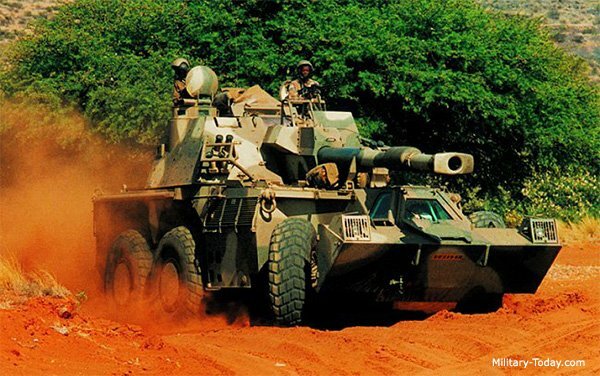
G6 Rhino ("Rhino")
Another sample of self-propelled artillery on a wheeled chassis was created almost at the same time as the "Dan", but far from Czechoslovakia - in South Africa. The development of the ACS, which received the designation G6 Rhino (“Rhino”), began at the end of 1970 in the state-owned corporation APMSKOR, and the first prototype appeared in 1981 year. The choice of a wheeled chassis was primarily due to the peculiarities of the terrain of the region, as well as the need to have a large stock of self-propelled combat equipment used by ground forces.
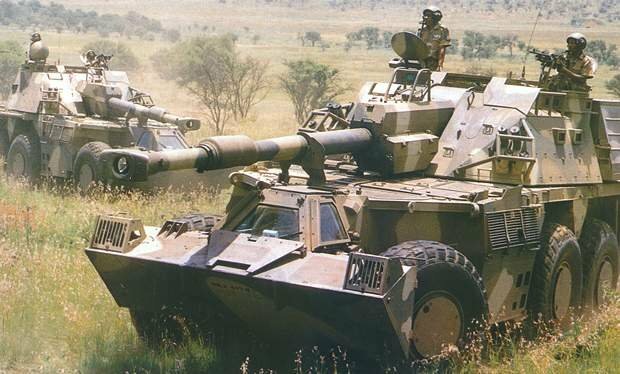
In front of the body of the ACS G6 there is a department of management, behind it is the engine-transmission, and then the combat, including an armored tower of circular rotation. The body is made of welded armor plates that protect against small-arms fire. weapons and artillery shell fragments. The bottom has a reinforced reservation against the action of mines.
The G6 uses an air-cooled diesel engine with an 525 horsepower.
The automatic transmission provides six forward gears and two reverse gears. All wheels - driving (wheel formula 6x6), front pair - driven. Wheel suspension - independent torsion bar, with hydraulic shock absorbers, it switches off during firing. Prior to this, using the hydraulic system, four supports are lowered (along the sides in the front and rear parts of the hull). Despite the significant combat mass in the 36,5 t, the G6 self-propelled howitzer has good mobility. Maximum speed on the highway - 90 km / h, and on rough terrain 35 - 40 km / h. Power reserve 600 km.
The armored turret houses: a commander, a gunner, and two loaders. For their entry and exit, there is a door on the right side and two hatches on the roof of the tower. In front of the tower on either side of the gun are four-barrel smoke grenade launchers. The commander's tower is equipped with periscopes of a circular view. A 12,7mm machine gun is installed in front of the loader's hatch for firing both ground and air targets.
The main armament of the ACS is a 155mm howitzer with a barrel length of 45 calibers. The tool pointing angles are vertically from 5 to + 75 °, and horizontally 80 °. Guidance drives - electro-hydraulic. To facilitate the loading on the left side of the shutter posted rammer shells. Powder charges in a combustible sleeve are placed in the charging chamber manually. A well-trained calculation ensures the 4 firing rate per minute for 15 minutes.
For firing from a howitzer, shots with fragmentation, smoke, lighting and incendiary projectiles are used. Ammunition - 47 shells and 52 charge. The maximum firing range of an ordinary high-explosive projectile is 30 km, and the high-explosive fragmentation projectile with a special bottom pyrotechnic nozzle is 39 km.
The fire control system (FCS), in addition to day and night sights, includes a laser range finder and an electronic ballistic computer. It can be connected to the battery MSA, receiving from there the necessary target indication.
Serial production of ACS began in the year 1988. Prior to this, several vehicles were tested during the fighting of the Yuarovo troops in Angola. At the end of 1990, the G6 party was acquired by the army of the United Arab Emirates.
The creation of two quite successful samples of ACS on wheeled chassis pushed designers in other countries to design similar systems. At the same time, one common tendency emerged - the rejection of the use of heavy multi-axle chassis and armor protection.
In fact, we are talking about replacing a conventional gun carriage along with a wheel drive and beds on a two or three-axle off-road truck. The creators are captivated by the high mobility of such systems, as well as the willingness to quickly open fire.
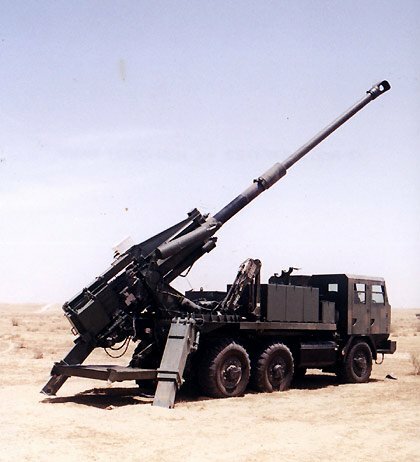
ATMOS system (Autonomous TruckMounted System)
One of the typical samples of new ACSs is the ATMOS system (Autonomous TruckMounted System), created by the Israeli company Soltam on the chassis of the Czechoslovak Tatra 815 truck (version 6x6). At the rear of the chassis are mounted a swinging part and an upper 155mm howitzer machine with a barrel length of 52 caliber. This ACS was created in 2001, almost by order of the Indian army, which shows increased interest in such systems.
The MOVAT - 105mm howitzer system installed on a two-axle truck cargo platform is being tested in the Netherlands. And in France, eight artillery ground troops re-equipped with self-propelled guns from the company Caesar GIAT Industries. 155mm howitzer is installed in the aft chassis of the all-wheel drive truck Renault 6x6. The machine is equipped with a light-armored cabin, fire control devices, as well as boxes for placing projectiles and charges. However, by the car they are transported a little. SAU Caesar can be transported by C130 aircraft. The installation is ready to open fire for 2 minutes. It should be noted that the United States and other NATO countries are showing interest in developing such systems.
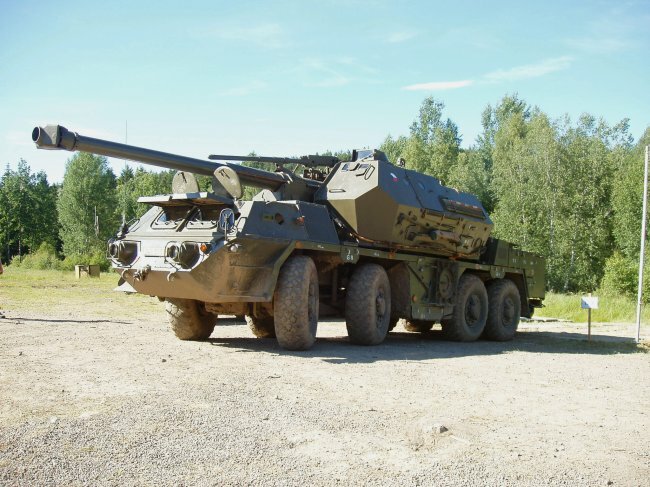
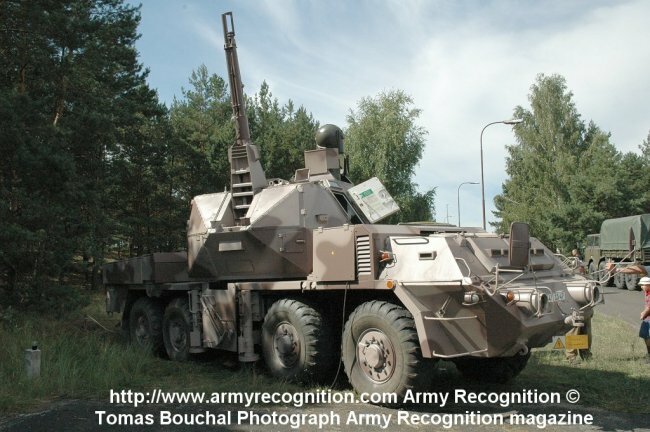
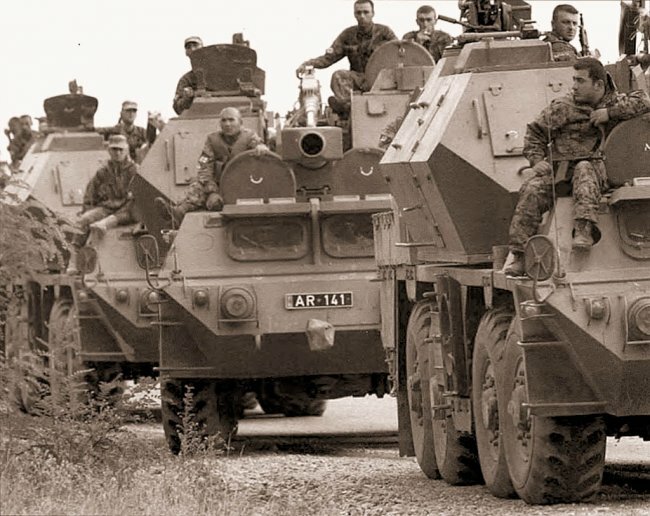
Information